2013 Yamaha WR450F Review
Yamaha's Open-class contender
Many dirtbike riders tend to associate European brands with state-of-the-art Open-class off-road racing motorcycles. After all, the vast majority of KTM sales are in the off-road market, Husqvarna has been on a slow but steady climb back into prominence, and smaller yet no less dynamic companies such as trials bike giants Beta and Gas Gas have devoted a lot of time and resources into manufacturing excellent big-bore off-road bikes.
But while only two of the Big Four manufacturers – Yamaha and Honda – sell competition-ready off-road machines, Yamaha’s WR450F is far from just a token entry in the market. Thanks to constant refinement over the years, the WR450F combines YZ motocross-style power in a lightweight, 250F-derived chassis with awesome handling. If you’re an off-road racer seeking an alternative to an expensive European machine, Big Blue may have the bike for you.
For the most part, the WR450F’s history parallels that of its YZ450F sister, beginning life in the late 1990s as a 400cc machine before being bumped in displacement to 426cc and then to its current 450cc engine size. Along the way, the WR has received numerous technical improvements learned from Yamaha’s YZ and WR race programs, and while the latest-generation WR450F still isn’t powered by a version of the YZ’s forward-positioned, rear-inclined-cylinder powerplant, its liquid-cooled 449cc DOHC four-stroke engine delivers the right kind of power for any off-road condition.
VIEW: Best Dirt Bike of 2013
Yamaha significantly improved the WR in 2012 by ditching its antiquated carburetor in favor of electronic fuel-injection. The benefits were numerous, including better throttle response and easier power tuning via adjustments to the ECU. But perhaps most importantly, the EFI made the WR450F EPA- and CARB-certified, meaning that it can be ridden on public OHV lands in all 50 states. The WR450F engine utilizes a dry-sump oiling system (the new YZ450F is a wet sump), but the oil is still carried in a reservoir inside the engine cases for mass centralization purposes.
Swing a leg over the WR450F, and the first thing you’ll appreciate is its handy electric-start feature. Not that the WR is hard to light off with its “accessory” kickstart lever, but for inseam-challenged riders or vets, less energy spent kicking equals more energy spent riding. Once the WR settles into an idle, you’ll also notice how smoothly it runs. Yamaha engineers worked on reducing vibration by paying careful attention to the WR’s crank balance in conjunction with the generator that powers the WR’s lighting system to quell harsh vibration. The WR isn’t a sewing machine, but it definitely emits less vibration than a YZ.
Out on the trail, the WR’s five-valve motor’s power curve is broad and muscular, and its YZ roots are evident in the form of a snappy delivery. Compared to the Honda CRF450X that we tested earlier this season, the WR feels racier, with a more robust mid-range and top-end lunge, but it is also less tractable, and we found that some of our favorite technical off-road sections that were manageable with careful throttle management on the Honda to maintain steady traction required more concentration on the Yamaha. While its fuel-injection and digital TCI ignition combine to keep the power crisp with a linear throttle response, the WR’s quick-revving engine feels like it has less flywheel mass than the Honda, and it’s willing to break traction sooner.
That said, it takes little more than a finger on the WR’s light and smooth clutch to keep rear wheel spin in line, and when traction is abundant, the WR has plenty of oomph. However, there are ways to really unleash the beast in the WR for improved closed-course racing performance. Removing the restrictive baffle in the WR’s repackable, USFS-approved aluminum muffler will allow the engine to breathe better, and swapping to a YZ throttle housing from the same year does away with the throttle stop required to help the WR meet emissions, unleashing even more power.
COMPARISON: Read our review of the 2013 Honda CRF450X
Buzzing through the gears of the WR’s wide-ratio five-speed transmission reveals acceptable shift quality. It isn’t as smooth as some of its competition’s, but we never missed a shift while riding the WR. The transmission ratios are spaced perfectly, with a low gear that can allow the rider to tackle tight terrain, such as when picking through tight woods or over rocks. And if you should find that you need to make a clutch adjustment when torturing the WR through gnarly, enduro-like low-speed sections, the clutch lever features an oversize barrel adjuster for on-the-fly adjustability of lever/cable play.
Despite a claimed wet weight of 273 lbs., the WR450F feels light and flickable on the trail at high or low speeds. It’s no feather, but its YZ250F-bred aluminum perimeter frame—a mix of castings, forgings and extrusions that comprise the main frame and a removable aluminum rear subframe constructed of square-section tubing—helps the big WR feel much smaller and lighter than it is.
Yamaha has clearly done a good job of getting all that weight where it doesn’t hinder the WR’s steering. Our testing included every type of terrain from hard-packed fire roads to sandy, wooded single track, and we never found ourselves wanting more steering precision. At high speed, the WR’s 57.7-inch wheelbase helps keep it as stable as an arrow, yet it is willing to change directions more quickly than a CRF450X.
The WR450F’s slim and flat ergonomic feel also helps handling. The layout allows the rider to move freely about the cabin when negotiating nasty terrain and maintain good leverage on the WR’s tapered aluminum handlebar. And while it is slim through the middle, the WR’s seat padding offers plenty of comfort when the rider is seated. We also appreciate Yamaha’s effort to keep the WR’s 2.1-gallon fuel tank and radiator shrouds slim despite the use of large-capacity radiators necessary to keep the high-revving WR from blowing its top in slow terrain where cooling air into the radiators is at a premium.
Yamaha’s YZ motocrossers may be a step ahead of the WR by sporting such trickery as the KYB Speed-Sensitive System cartridge fork, but the WR is no slouch in the suspension department. Up front, its fully adjustable KYB 48mm cartridge-type fork delivers 11.8 inches of plush, controlled travel, while its KYB piggyback reservoir shock matches the fork’s performance with 11.6 inches of travel. The shock is adjustable for high- and low-speed compression damping as well as rebound damping and spring preload. The shock is mated to a tapered swingarm that uses YZ-style linkage to keep the rear suspension compliant whether hammering across adobe-baked whoops or plowing through sand.
COMPARISON: Read our review of the 2012 KTM XC Enduro Line
Hauling the WR down from speed are wave-style brake discs designed to reduce unsprung weight. Both the front and rear calipers feature aluminum pistons and offer plenty of stopping power with a linear feel, and the front brake lever is adjustable to tailor the braking feel to rider preference. The brakes are mounted to stout hubs laced to high-quality Excel rims measuring 21 inches in diameter up front and the off-road standard 18 inches in the rear (vs. a 19-inch rear for motocrossers). The wheels feature collars that make wheel removal quick and easy, bonus in events where pit stops to change tires may be necessary. The WR’s Dunlop tires offer consistent grip and feel regardless of terrain.
There are a lot of other neat details to appreciate on the WR as well. Chief among them is a digital enduro computer that offers basic speedometer, clock and tripmeter functions as well as a “race mode” with more advanced, enduro competition-worthy functions such as a timer, distance-compensating tripmeter and average speed.
The computer is mounted on the WR’s triple clamp, which is forged rather than cast. Other WR-specific off-road equipment includes a one-piece plastic skid plate that shaves weight while still offering the engine cases a measure of protection, and a 35-watt headlight and LED taillight designed to maximize visibility while drawing a minimum of electrical current. Lastly, the WR’s air filter maintenance is facilitated by tool-less removal.
For a retail price of $8290, the Yamaha WR450F represents a lot of bang for the buck in the Open-class off-road world. Attributes such as zippy motor performance, excellent handling and plush suspension make it competitive right out of the crate. Its electric start and comfortable ergonomics all but assure that you’ll be able to enjoy hours of off-road fun with your pals during any off-road adventure.
And if a race should happen to break out, we’re betting on blue.
More by Scott Rousseau



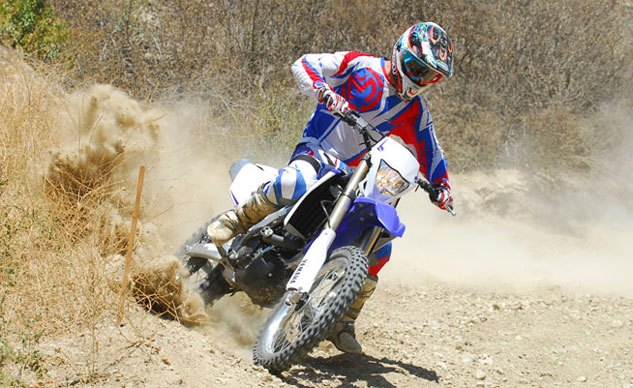

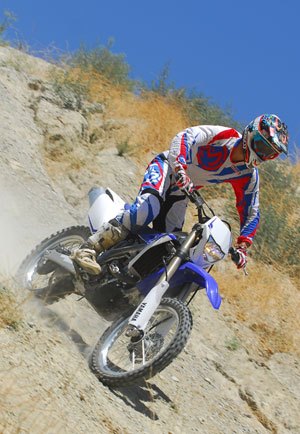






















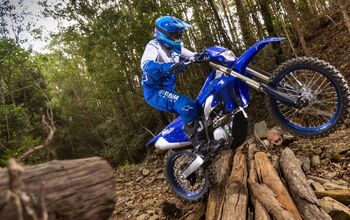
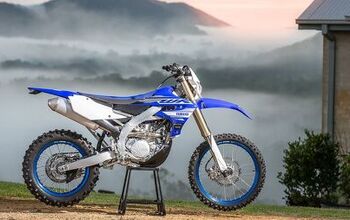
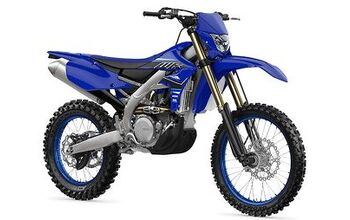














Comments
Join the conversation
I bought the 2012 and this review is spot on. With the throttle stop and exhaust restrictor baffle in place, you may as well be riding something around 200cc. I have about 2,000 miles of rough desert riding on mine and want to mention a couple issues. 1, that plastic skid plate is probably nice for nice dirt / woods riding, but not for the desert. It lasted about about 250 miles worth of riding (broke 2 of them before getting a GYTR aluminum). That exhaust silencer is kind of big. I trashed 3 of them with relatively minor falls. It uses the same muffler as several other year WRs, you just need to use the asbestos or whatever that bushing is that lets it couple with the front exhaust tube from the 12-13. I'm not sure if the 13 is using the same digital enduro computer as the 12, but you can't even see what speed you are going if on anything less than a paved road; the contrast is horrible. I should have probably got the programmable ECU and put in another map, but I didn't and likely won't. That being said, the bike really doesn't want to start very easy when "cold" (like hasn't started, not temperature wise). I checked valves and it just did this from day one. It has to crank a little, then when it starts, it's finicky. Throttle may cause it to die, etc. I have a 07 YZ450F and both bikes are fairly similar. They are both capable of about the same speeds, but the WR is way more forgiving. The valving is way nicer on the WR and both motorcycles are using the same forks. The WR also feels a lot heavier (especially when loading it into the truck). While riding, it feels like there is an extra 20lbs on the front of the WR as opposed to my YZ. With all being said, I grab my WR for my rides about 8 out of 10 times. The bike is awesome, and I personally walked out the door with my 12 for $6,400 (No Tax - In Oregon).
The WR engine has been a stalwart for years. Long known in the off road community to be reliable and strong, the WR450 engine is a gem that is only enhanced by the addition of FI.
The WR may not be the ulitmate race weapon (the KTM 300 XC or it's near twin Husaberg TE300 2 strokes are) but the WR remains capable and probably the best serious trailbike choice for the rest of us.
Factory supported racer Paul Whibley makes that WR hustle nicely though :)